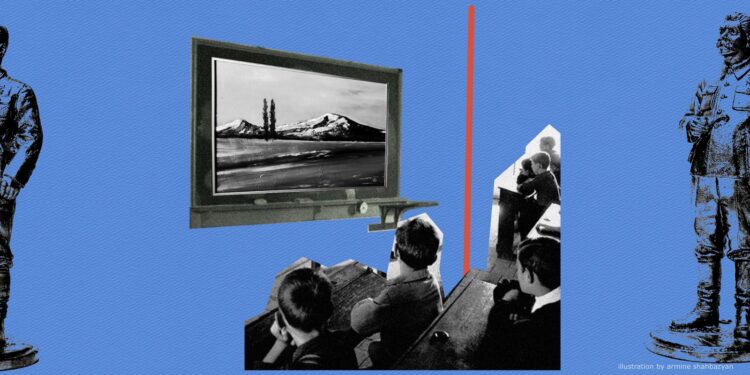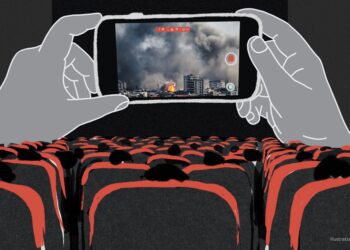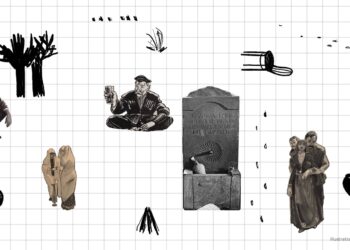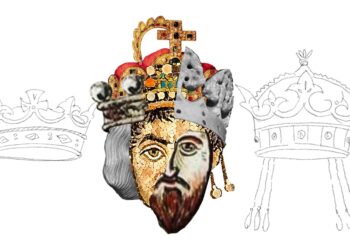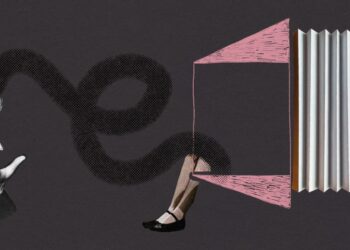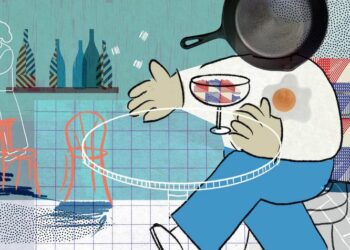Et Cetera
From Artsakh to Gaza, No One Will Be Free
An Armenian film, “1489” won the Main Jury and the International Federation of Film Critics prizes at the International Documentary Film Festival of Amsterdam in 2023 amid upheaval and controversy that triggered a series of withdrawals and boycotts of the festival for its perceived silence regarding Israel’s invasion of Gaza.
Two Films From One Fountain
The juxtaposition of two cinematic adaptations of the same literary work reveals polar perceptions of history, tradition, national culture and lifestyle. And by doing so, it indicates that the boundaries of "Armenian cinema" are much wider than they seem.
Daniel Dznuni: The Interrupted Flight, Part 2
Armenia’s first and only cinema mogul, Daniel Dznuni, was accused of sabotaging the work of Armenfilm in 1936. After spending several years in prison, he was released but never returned to the theater. Part II of Anush Vardanyan’s exploration of Dznuni’s life and work.
The Now of Literature, After the War
How does war shape the collective narrative? How have Armenian writers since the 1990s approached the impact of multiple wars? Mariam Aloyan looks at Armenian “war literature” spanning generations and decades.
The Russian “Gift of Civilization” to Armenia: “Relocant” Edition
The unprecedented influx of Russian citizens due to the Russia-Ukraine war into states that were under Moscow’s rule for centuries, is often locally perceived as endangering the identity and undermining the independence of these states. Maria Gunko explains.
The Experience of Alienation in Atom Egoyan’s Films
Film critic Alexander Melyan takes the reader on a journey of Atom Egoyan’s films that explore complex narratives including the immigrant experience, nostalgia, the search for home and longing for a lost homeland.
The Unsettled Frame: The Quiet Politics of Hagop Hagopian’s Art
Through his art, Hagop Hagopian was changing the lens on the idea of Armenia as a mythical topos, an atavistic construct of the Armenian paradise. Instead he presented a land of extreme harshness and desolation in which life can happen only as a product of tremendous effort and unconditional belief.
Headfirst Into the Rabbit Hole: An Ode to Cultural Anxiety
Self-pity and victimhood have served as comfortable escape routes from pervasive issues, however, in the current post-war reality there are clear signs that there is a desire to address the fault lines, to understand and rethink the reasons behind past failures, to stop and reflect.
Exhibiting “Armenian” Nudity: A Decolonial Approach to Art History
A recent exhibition “The Guises of the Nude: Perceptions of Nudity in Armenian Graphic Arts” provided a powerful opportunity to challenge prevailing meta-narratives and foster a self-reflective dialogue that can contribute to the broader project of decolonization and social transformation.
The Regional Policies of the Cannes Film Festival
Major film festivals don’t only showcase films for local and international cinephiles, they also create opportunities for unknown stories, names and voices to be heard. Sona Karapoghosyan writes about how the Cannes Film Festival is trying to tell the stories of everyone, not only ones from the West.
Living Portals: Reflections on Territorialization in Contemporary Armenian Art
A review of an exhibition in the village of Verishen in Armenia’s Syunik region featuring a contemporary carpet collection by Goris-born artist Davit Kochunts, examines the concept of social space and the process of territorialization.
Don Quixote: Present and Absent in Armenian
The Armenian translation of Cervantes’“Don Quixote” has not yet reached readers, despite being a masterpiece of world literature. Aram Pachyan delves into the reason behind this.
A Vision of Power: The Royal Crowns of Cilicia
Crowns worn by monarchs reveal stories of hierarchy and power, providing insight not only to those who wore them, but the strata to which they belonged. Margarita Ghazaryan looks at the story of the royal crowns of the Armenian Kingdom of Cilicia.
Art as a Tool for Conflict Transformation and Healing War Trauma
Art can be an effective tool of conflict transformation impacting societal attitudes and perceptions by producing a cathartic effect on both artists and audiences, writes Anna Kamay.
5 Dreamers and a Horse
The directors of the documentary “5 Dreamers and a Horse” manage to think outside of genre limitations, and to blend the elements of magical realism and cinéma vérité to create a strange fairy tale that resembles the one in which we all live.
Love and [un]Love in “The Miracle Worker”
Nune Hakhverdyan reviews the Armenian production of “The Miracle Worker” staged by the Gyumri Drama Theater and Yerevan’s Hamazkayin Theater about the life of Helen Keller, and examines the relationship between parent and child.
Exhibition Outside of the Traditional Art Space
In Armenia, there are few exhibitions outside of the traditional art space environment, but at the same time, one can notice distinctive new trends emerging in recent years.
The Armenian Dream: Michael Goorjian’s Film About Charlie the Repatriate
Michael Goorjian’s feature film “Amerikatsi” succeeded in infusing a sentimental and “positivist” tone inherent to Hollywood cinema within an Armenian reality, writes film critic Sona Karapoghosyan.
Reinterpreting Our Medieval Cemeteries
Cemeteries serve as a reflection of societal beliefs, values and ideas and impact how we live and develop our identities; there we find every human manifestation, from the subtlest to the crudest.
Kafka in Artsakh
Garegin Papoyan’s film “Bon Voyage” manages to recreate a Kafkaesque world in the form of the Stepanakert Airport, where people follow a seemingly unreasonable system, and continue to do their work with incredible persistence, without questioning its meaning.
When Futurists Met Their Coveted Future
Even though a collectivist and masculine culture is predominant in Armenia, it’s often challenged by smaller segments of the society that are proponents of individualistic values and/or advocate gender equality.
Global and Local Art Wars
The inclusion of two conflicting Armenian artists from different eras on a prestigious platform of global contemporary art reveals the need to fundamentally reconsider and rethink the Armenian artistic heritage of the recent past.
Waiting for Spring…
In this review of the film “It Is Spring” dedicated to the Artsakh conflict, Sona Karapoghosyan writes that cinema should be a tool for critically revealing and interpreting the world, and not a bandage to hide our collective complexes and fears.
Power Is (the) Truth
During March 2022, the Word—not only allegorically, but in the most literal sense—finds itself outstretched like the Vitruvian man strung from the corners of our Armenian-Russian-Ukrainian semiotic triangle.
Archive Fever: Vanadzor’s Bucolic Past in Hamo Kharatyan’s Photographs
How a tightly rolled bundle of negatives taken by Hamo Kharatyan in the 1930s slowly began to reveal astonishing, quite unfamiliar aspects of Vanadzor's life that were already on the verge of disappearing.
Lilit Teryan: The Doyen of Iran’s Modern Sculpture
Known as the mother of modern sculpture, Lilit Teryan left an indelible mark on Iran’s art scene. Although teaching sculpture was banned following the 1979 revolution, Teryan continued creating and eventually returned to instruct a new generation of Iranian artists.
Gyumri: A Century of Textile
In its quest to rediscover itself, Gyumri is continuing the traditions of the textile industry which in turn is inspiring new initiatives.
Studio Belle: Armenian Photo Studios and the Changing Standards of Female Beauty
The first Armenian-owned photo studios in Constantinople and Tbilisi at the end of the 1850s not only immortalized people’s lives, they were an effective shortcut to modernity and a powerful symbol of cultural emancipation.
A Living Canvas on Stage: Towards Contemporary Dance in Armenia
While contemporary dance is still seen as a very niche and esoteric “corner” of Armenia’s performing arts landscape, it is starting to flourish with many young dancers from Armenia and abroad involved in making this change.
Waste: The New “Raw Material” of Modern Art
Most exhibitions organized in Armenia in the post-war period refer either to the war or to related topics. Two recently-opened shows depart from this context, referring to a more broadly “warlike” situation—the issue of waste.
Finding Ararat in Kilittaşı: Reflections on a Trip to Ancient Bagaran
Despite all the attempts to forget or eradicate it, the ancient Armenian village of Bagaran that lies on the very edge of the Turkish-Armenian border, is a metaphorical manifestation of this region's rich and tragic history.
The Doctors of Armenian Cultural Heritage
Examining the dissonance between the importance ascribed to national values like cultural heritage and the less-than enviable conditions surrounding the profession of Armenia’s “heritage doctors”.
Re-reading Philip Marsden’s “The Crossing Place: A Journey Among the Armenians”
Philip Marsden’s “The Crossing Place: A Journey Among the Armenians” is atmospheric, gripping and revelatory. It delves into the seemingly exclusive club of a nation at the meeting point of cultures, writes Naneh Hovhannisyan.
Behind the Magic: Rudolf Vatinyan’s On-Set Photographs From “Khatabala”
When cinematographer Rudolf Vatinyan passed away from COVID-related complications in 2020, people eulogized about an exacting professional who had filmed a number of iconic films. No one remembered, however, that Vatinyan had a parallel creative passion.
Kond: Urban Information Storage
Kond is the oldest surviving vernacular neighborhood in Yerevan. Its significance lies not in the current cultural, social and political interpretations but rather in this district’s capacity to store and transfer information across generations.
The Cinema Screen: A Political Battlefield
Mher Mkrtchyan has made a marked and oppositional political film, which, however, is too superficial and collapses under the incredible transparency of its agenda, writes film critic Sona Karapoghosyan.
Meghri: A Fuselage of Memory
There is a Facebook group of Meghri natives that is more active than the official pages of many institutions. It is, however, also isolated, living a separate life, disconnected from the rest of the digital world just like the actual city.
Notes From a Future Museum: Bagging Up Ideologies
How a black evening handbag found among countless items in Yerevan’s largest flea market revealed a paradigmatic shift from the egalitarian criteria of Soviet ideology, which accorded functional objects with purely practical properties.
Interrupted Flavors: Thoughts on Armenian Cuisine
Attitudes toward food and culinary art can reveal much about a people’s past and future. Ella Kanagerian writes that we are trying to work with our cultural influences and approach the concept of national cuisine more consciously.
The EDM Kitchen։ Electronic Dance Music in the Context of Gender
Electronic dance music, as a relatively new cultural phenomenon, could have been occupied by women, but even here, the presence of men is predominant and women have to fight for fair representation.
Did the Wind Drop? Nora Martirosyan’s Optimistic Drama From Artsakh
Director Nora Martirosyan’s film “Should the Wind Drop” reveals the frustrating situation surrounding the airport as a starting point to delve into the history, problems and spirit of Artsakh.
Rediscovering the Body: The Painful Birth of Post-Soviet Performance Art
Although performance art has practically disappeared from the contemporary art scene as an autonomous medium, early practitioners had a profound impact in changing perceptions of the body in Armenia’s post-independence culture.
Notes From a Future Museum: The Aesthetic Politics of Armenian “Chekanka” Art
Hybridizing fine art and mass culture, Soviet-era “chekanka” art generated an unconventional visual world in which ancient and modern mythologies, as well as sexual and political desires could be blended into a patently local cultural narrative.
“Michael Jackson, Know This Well, I Can’t Bear This Pain”
The “Top Ten of Rabiz” was a series of albums produced by a group of young men trying to reproduce the scattered reality of the 1990s through the language of music and an experimental format that was never really “rabiz.”
Back to the Future: The Evolution of Post-Soviet Aesthetic in Armenian Fashion
The Armenian love for following trends is something that is a part of the collective cultural and political history. And that tendency became stronger after the collapse of the Soviet Union.
“Where Are You, Soghomon?” Arman Nshanian’s Melodrama About Komitas
“Songs of Solomon” promises to tell the story of young Komitas but ends up disappointing as the direction drastically changes, turning into another tragic film about the Armenian Genocide and Komitas simply a faded symbol emphasizing a lost culture and history.
“Return the Tramway to Yerevan:” About Aram Pachyan’s Novel “P/F”
Literary theorist Tigran Amiryan takes the reader on a journey into the essence of Aram Pachyan's experimental novel "P/F", noting that while it might not appeal to aficionados of fictional prose it will cause an unquenchable thirst for contemplation.
Escaping to Cafes: Yerevan’s 2021 Gastronomic Trends
In the past several years, residents of Yerevan have started spending more time in cafes and the outdoors generally. We eat out, take our breaks, work and escape from the cares of our daily lives.
Listening to Imagine: A Post-Crisis Exhibition Attempting to Reimagine Armenia’s Future
The ongoing crises in Armenia are forcing old ideas about the future to crumble, making way for as yet undefined horizons. In this process, contemporary art tries to intervene to create new spaces for imagining the future.
Notes From a Future Museum: Time-Keepers
Vigen Galstyan explores the humble charm of Soviet Armenian mechanical clocks in this first instalment of a series of articles about Armenia’s not-too-distant past as a major producer of everyday consumer goods and a hot spot for industrial design in the USSR.

